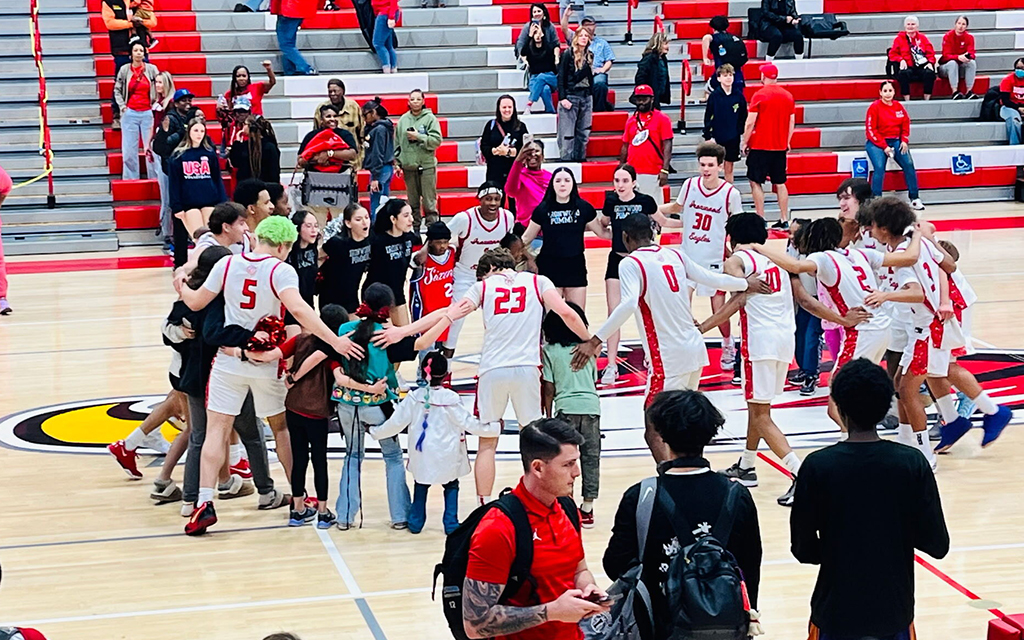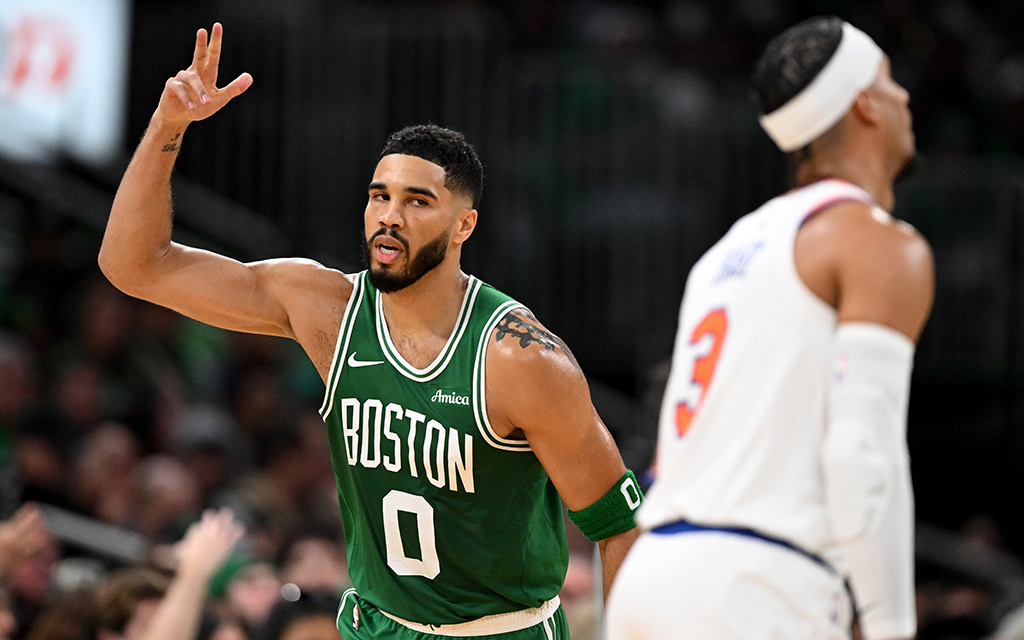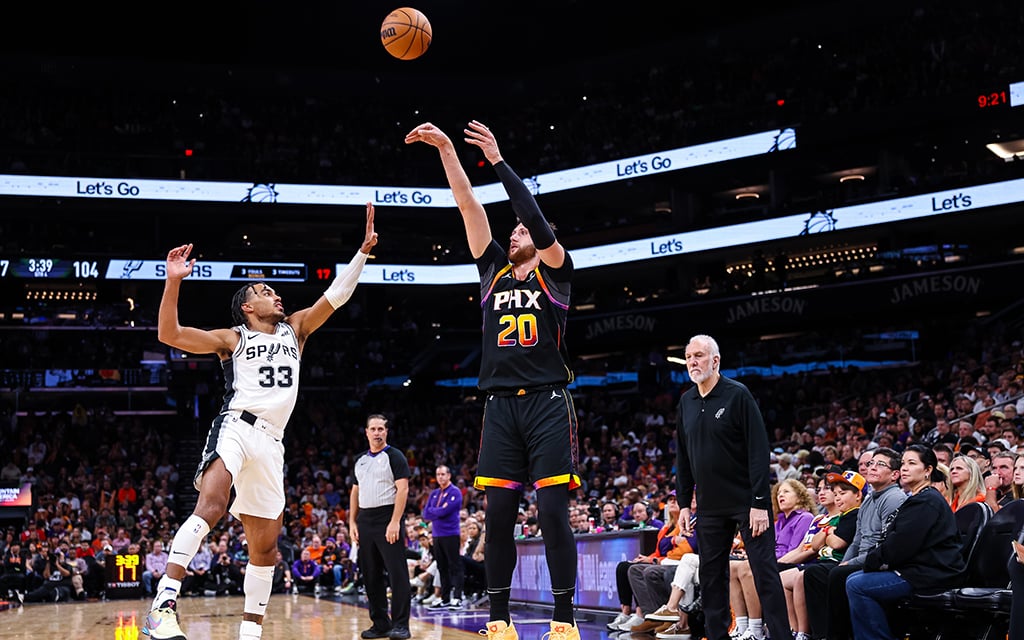PHOENIX – Over the last few seasons, NBA fans have watched players shoot an audacious number of 3-pointers. Teams this season have fired 37.5 3-point attempts per game, the highest mark ever.
High school coaches and players, including those in Arizona, have watched the evolution intensely, with some teams eagerly embracing the trend. Valley Christian boys basketball coach Greg Haagsma had his players on the trend early.
“I would say back as early as 2010-11, we really saw us focusing on becoming better as a team in that regard and just shooting a lot more, but truthfully even back as far back as 2003-2004,” Haagsma said. “It just probably wasn’t quite as big of a part of who we are as what we are today.”
The Boston Celtics average 48.5 attempts per game this season, a mark that will likely break the 2018-19 Houston Rockets record for most 3-pointers attempts per game by a team in a single season.
Boston is aiming for back-to-back championships this season, playing under coach Joe Mazzulla’s bold offensive system. Last season, the Celtics attempted 42.5 3-pointers per game and 40.2 attempts during the playoffs. Through their first 75 games of the 2024-25 season, Boston shot 3,636 3-point shots, making up roughly 54% of their total attempts.
The 3-pointer conversation became a hot topic beginning in 2015, when the 3-point revolution arguably began. That was the same year Golden State Warriors star Stephen Curry began his rise to global stardom by winning his first championship and MVP honors. Teams that season only attempted 22.4 3-pointers per game, while Curry and his backcourt partner, Klay Thompson, attempted a combined 1,191 3-pointers during the same period. The Warriors shot 2,217 3-pointers in total, roughly 31% of their total shot attempts.
For the next four seasons, 3-pointers made up roughly 36% of the Warriors’ total shots in the 2015-16 and 2016-17 seasons, 34% in 2017-18 and 38% in 2018-19. They made the NBA Finals in each of those five seasons, winning three championships. The NBA has seen a sharp increase in 3-pointers attempted per game since Curry’s first MVP season, transcending and changing the game forever.
Despite the transcendence, NBA ratings are down this season and there are multiple reasons that fans have proposed as reasons for the abrupt decline. Some fans believe the games need to be more accessible to fans. Some blame the players for not trying hard during All-Star weekend, and some argue that teams need to shoot less 3-pointers.
I’ve been to 9 of the last 11 All Star weekends and for some reason this one is just.. depressing.
— Rachel A DeMita (@RADeMita) February 17, 2025
“The league needs to change the rules…You are playing a dangerous, dangerous game.”@getnickwright on the state of the NBA: pic.twitter.com/qUSJrIYryR
— What’s Wright? with Nick Wright (@WhatsWrightShow) October 24, 2024
The topic of 3-pointers is a double-edged sword conversation for Haagsma. He believes the 3-pointer is beneficial, but the NBA emphasizes the shot so much it takes away the players’ ability to show off the rest of their talent.
“We’ve probably gone, in basketball, a little bit too much of the analytics instead of what can help a particular team be more successful,” Haagsma said.
The evolution of the 3-point shot in the NBA stretched to the younger generations, a trend that appears to be on the upswing. The trend has not dramatically impacted college basketball, as the average number of 3-pointers attempted per game has stayed between 20 and 23 since 2015.
However, it reached new levels with high school basketball teams. Some of the best high school teams in Arizona that made it far in this year’s playoffs shot more 3-pointers than the rest of the nation.
The two teams that made the 3A boys high school championship this season, Haagsma’s Valley Christian and Gilbert Christian, made 305 of 824 attempts (37%) and 260 of 833 attempts (31%), respectively. The Ironwood Eagles in Glendale, which made the quarterfinals of the Open State playoffs this season, made 255 of their 749 3-pointers, a 34% clip.
The national average is 109 3-pointers made out of 369 attempts.
Gilbert Christian coach Jason Pasquariello is a fan of the math game and analytics. His teams need to play fast and try to kick ahead for early shot clock 3s, take the best available shot in the possession and eliminate contested mid-range jump shots and 3s.
“The biggest thing we emphasize is, if you’re open, your feet are set and there’s nobody that has a better look than you, then your job isn’t to be out there just getting exercise,” Pasquariello said. “(Your) job is to score the ball when you’re in the game.”
The freedom Gilbert Christian’s players have to shoot plays a part in the increase of 3-point attempts, especially since this generation’s players grew up watching sharpshooters such as Curry, Thompson and Damian Lillard launch from outside the perimeter.
As much as Haagsma and Pasquariello encourage players to take those shots, Haagsma also has them understand that there is more to offense than just launching from beyond the arc.
“Philosophically, as a coach, I don’t think that there necessarily is a time always that you have to say, ‘I’m definitely going to get a post entry this time,’ or ‘We’re definitely going to get a 3 this time,’” Haagsma said. “But we have multiple options off of everything that we do and it usually has both involved.”
When it comes to creating scoring opportunities, coaches have to adapt depending on the defense that teams experiment with on any given night.
Jordan Augustine, coach of Ironwood’s boys basketball team, has seen multiple defensive looks for his 3-pointer-centered offense. Teams that crowded the paint and forced Ironwood to shoot more 3-pointers paid the price by watching Ironwood happily take those shots.
With more teams beginning to shoot more, teams have employed what Augustine explained as “stick principles” on defense.
“You’re guarding your guy. You’re not helping,” he said. “And in the NBA, and a lot of other levels, switch everything to keep everything in front. And then you have one guy that you’re willing to help off of and live (with the result) if that’s the guy that beats you.”

Ironwood High School boys basketball players and fans huddle after an 87-52 victory over Sunrise Mountain on February 11, 2025. (Photo courtesy of Tim Jones)
In the 2018 Western Conference Finals, the Rockets offered a prime example of stick defense against the Warriors.
During one particularly telling series, Houston’s Chris Paul, at the top of the screen, was not moving into the paint the way a player would in a help defense scheme. Trevor Ariza switched opponents with Gerald Green when Kevin Durant set an off-ball screen for Kevon Looney at the free throw line, ending with Ariza chasing after Looney. Looney set a screen for Curry on the wing, and Ariza and Eric Gordon switched opponents again.
Take this play for example (ft. multiple current and former Suns). CP (top of screen) is not helping from the corner, and multiple switches from Trevor Ariza, Gerald Green and Eric Gordon on on-ball and off-ball screens, baiting Steph into taking an out of rhythm 3
(3/5) pic.twitter.com/gIA73zwCml
— Ian Monje (@IanBMonje1) March 3, 2025
This concept has become common for attempting to stop good 3-point shooting teams. The best teams (like that Warriors team) adapt and continue to win regardless of which defense other teams implement.
It begs the question: should more high school basketball teams copy what the top NBA teams are doing and shoot more 3s?
For high school basketball coaches like Augustine, the style of offense a team runs depends on the players on the roster. Take Perry High School this season, for example, which was led by senior five-star recruit Koa Peat, who will attend Arizona, and three other players who are above 6-feet-5-inches. Due to their size, Augustine understands Perry’s offense was built around playing physically and getting to the rim.
Not every team will play that way; it is all about each team’s personnel, philosophy and finding the unique advantages a team possesses.
“If it’s the advantage that you have as a group, that when you play fast you have open 3s, then I think that what we’ve defined as being a bad shot for a long time is now a very good shot in basketball,” Augustine said.
Regardless of that philosophy, the shot will remain an integral part of basketball on all levels. Perhaps remaining patient throughout the course of time and the course of the game is the way to approach an offense that revolves around 3-pointers.
“Maybe we need to be a little more patient and see the ball go in a few times before we start really hunting,” Pasquariello said. “Get into a rhythm first, and then, let’s let it fly.”


